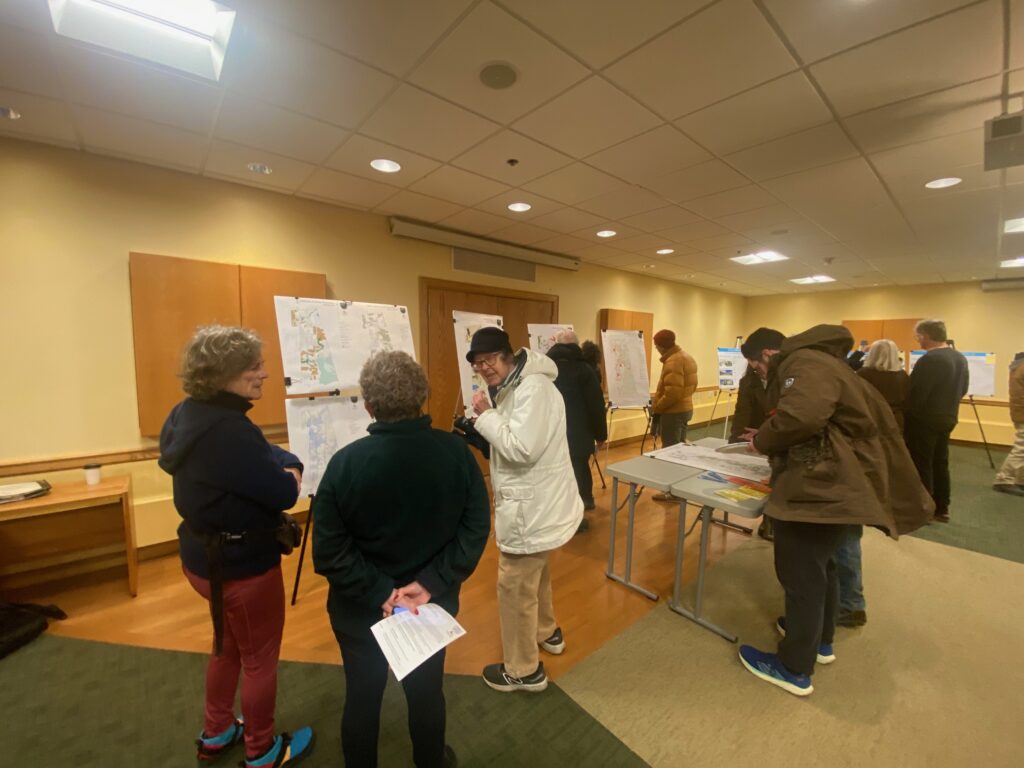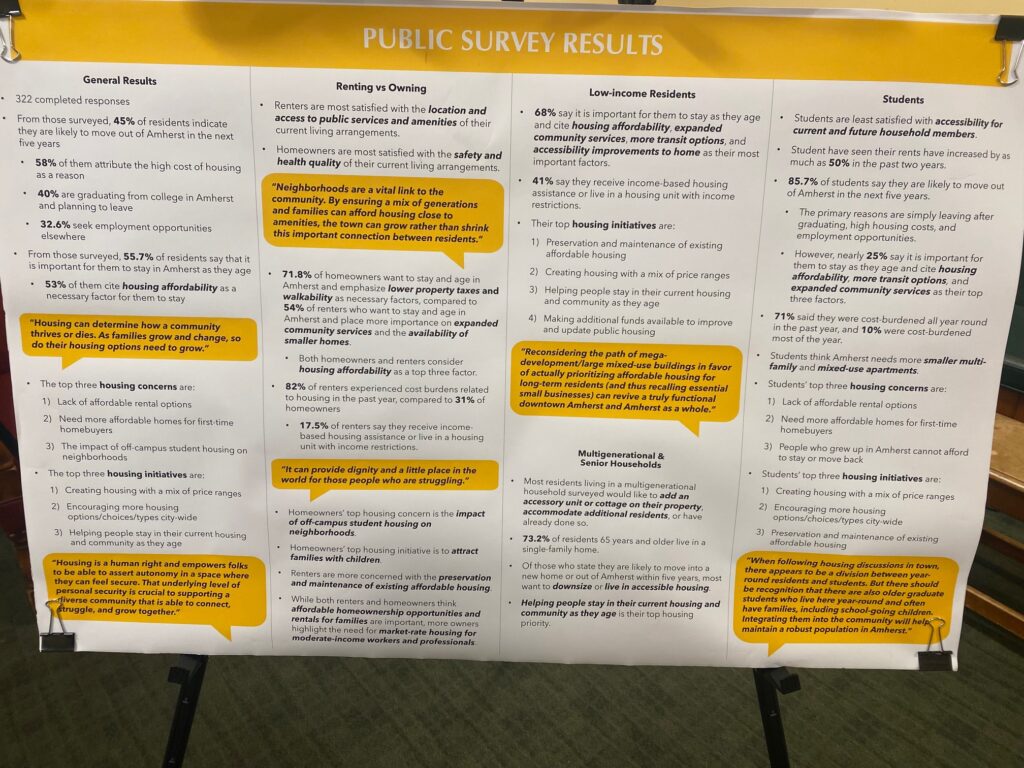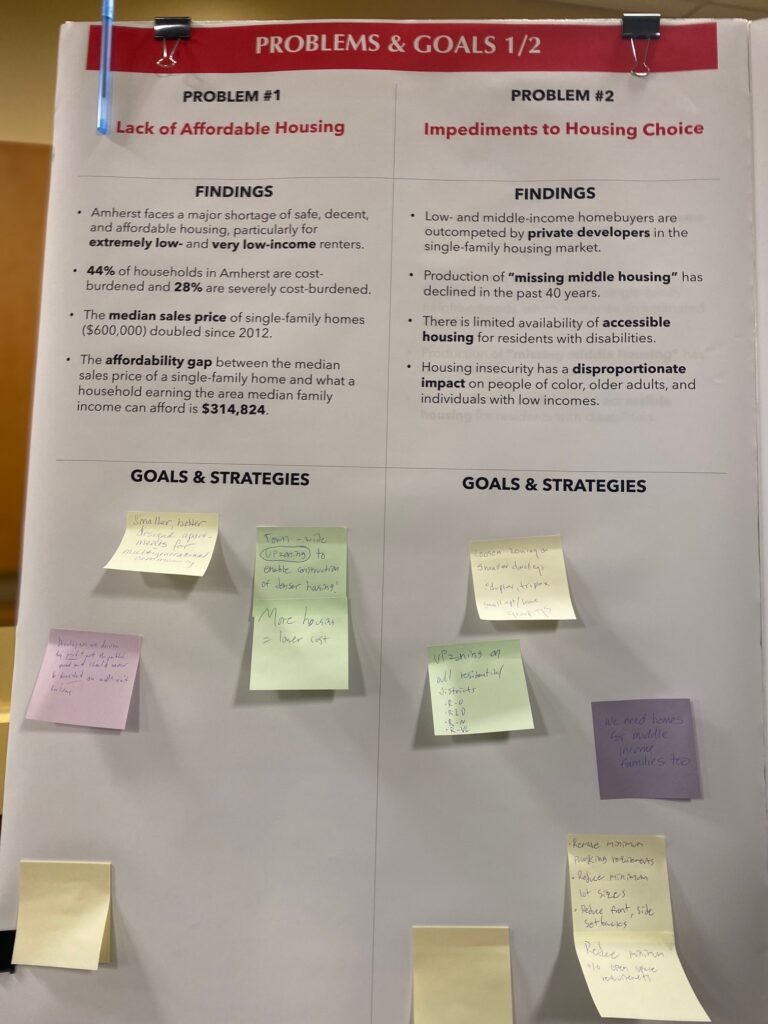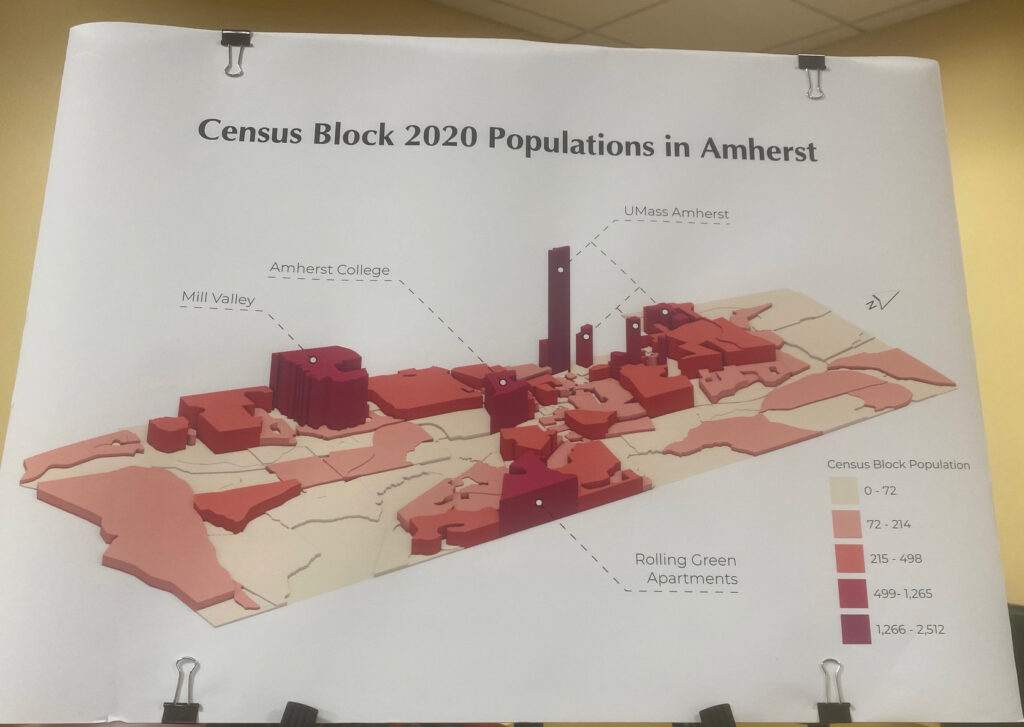Housing Production Event Draws Enthusiastic Crowd

Participants at the Housing Production Plan Open House on January 7, offered feedback on the town's housing needs on an assortment of maps and posters. Photo: Art Keene
As part of its development of an updated Housing Production Plan (HPP), Barrett Planning Group held an open house in the Woodbury Room of the Jones Library on January 7 to gather input on goals and strategies for housing in Amherst. The informal gathering drew over 50 people who were invited to offer comments at five stations set up around the room. The stations were:
- Project overview and timeline
- Mapping activity and scenarios where attendees were asked which types of housing should be developed in Amherst and where, and what factors will impact Amherst housing in the future.
- Visual preference survey: which types of housing are preferred by Amherst residents
- Goals and strategies: how should Amherst address challenges facing the town.
- Visioning board and drawing activity for children: describe Amherst at its “housing best”
Attendees were encouraged to express their preferences by placing stickers on the maps and posters and adding sticky notes with comments to the data sheets and photos.
Barrett Planning held stakeholder interviews in August and September and held two community meetings in October. They then conducted a public survey that garnered over 300 responses. From this community engagement, the group developed a housing needs assessment. After compiling the comments about the needs assessment and input on housing goals, including production targets, Barrett will work with the Planning Department and housing advocates to design an implementation plan to complete the HPP this spring. Amherst’s previous HPP was completed in 2013. Recently retired Town Planner Christine Brestrup told the Planning Board on January 8 that it was important for Amherst to have a valid HPP to apply for grants and to shape housing in town.
The Amherst population is largely dominated by ages 18-24 and over 65, with the loss of 40% of children in the regional schools in the past 30 years. Only 27% of residents are between the ages of 25 and 64. Over half of Amherst residents are renters and 58% of them spend more than 30% of their income on housing, with 82% of renters saying that they have experienced cost burdens in the past year.
The draft housing needs assessment showed that Amherst doubled in population over the past 20 years, largely due to the growth of UMass. But population is expected to decline over the next several decades. The Amherst population is largely dominated by ages 18-24 and over 65, with the loss of 40% of children in the regional schools in the past 30 years. Only 27% of residents are between the ages of 25 and 64. Over half of Amherst residents are renters and 58% of them spend more than 30% of their income on housing, with 82% of renters saying that they have experienced cost burdens in the past year.
The needs assessment shows a need for housing at all income levels, but especially for those with very low incomes. However, with the median sales price of a house in Amherst reaching $600,000, even families earning 100% of average mean income of $97,000 cannot come close to purchasing a home in town. Amherst’s house prices and rents far exceed those of surrounding communities.
At the January 9 meeting of the Amherst Municipal Affordable Housing Trust, Barrett representative Tony Duong and Amherst Planner Greg Richane gave a preliminary report on the input gained from the open house and further analysis of Amherst’s housing. Duong stated that LLC’s have purchased 75 single-family homes since 2019, 52 of which were homes owned by a long-term Amherst resident. The top three concerns of respondents to the housing survey were the lack of affordable rental housing, the need for more affordable homes for first-time homebuyers, and the impact of off-campus student housing on neighborhoods. The top three initiatives proposed were creating housing with a mix of price ranges, encouraging more housing options citywide, and helping people stay in their current housing as they age.
Richane was pleased with the turn-out at the open house, although he admitted that it was skewed toward an older population but said the survey respondents were more diverse age-wise. He said, “I spoke to at least a couple people who perhaps didn’t have fully formed ideas, but were drawn to the issue. That tells me that there’s growing attention to housing issues in Amherst.” From his initial impression of the responses at the open house, he said people seemed to prefer cottage cluster or cottage style developments with two- or three-family houses and accessory dwelling units. Mobile homes, larger single-family homes, and multi-family apartment buildings were the least preferred housing options.
Town Councilor Pam Rooney (District 4) pointed out that the data do not show how off-campus students are accounted for in age distributions, in income distribution, and in housing affordability (cost burden), and in calculating the actual year-round population. Duong did state that students living on-campus were not included in some of these calculations. Rooney also noted, “One panel asked what type of housing would be acceptable in Amherst, but there was no clarification of where that type of housing might be appropriate and where not appropriate. Many people added a sticky note stating, ‘It depends on the location.’”
Cathy Schoen (Town Councilor, District 1) stated that the town maps illustrated the small amount of developable land in Amherst, with much being conserved for recreation, farmland, educational institutions, and wetlands. She suggested “creative ideas for re-use/development of town owned property offers potential for yielding more housing. The closed South Amherst School is one example. Another is Wildwood Elementary School, once the new Fort River School opens. Schoen suggested that given the Wildwood acreage and proximity to town, there is the potential for a public-private partnership with a new building that has public space on the ground floor (senior center, youth center, preschool, other?) and owner-occupied apartments (condominiums) on a second and third floor for those 50 and older. If developed as one, two and three bedrooms condos, this could enable residents to move out of single-family homes into a building near town with ample parking and open green space. The developer could retain the gym or cafeteria for first floor space for the public and residents. Such a development would put the town property on the property tax rolls and provide much need senior housing, freeing up other homes for families.



